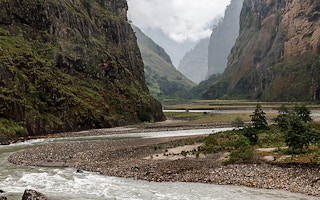Transboundary river basins in south Asia are some of the most productive social-ecological systems, and they are also at most risk. A number of factors are increasing the pressure on these river basins. These include growing demands for food, energy and water combined with unsustainable land and water management practices. O
n top of these, climate change impacts such as faster glacier melt and other water-induced hazards like droughts and floods exacerbate vulnerabilities of the communities, economies and ecosystems in these basins.
While these basins are integrated ecological systems shared between two or more countries, joint resource governance mechanisms are limited to water sharing at best and are mostly determined by economic and political priorities and interests of individual countries.
This has resulted in fragmented and disjointed water governance systems in these basins with limited scope for, and investments in, collective efforts to share the benefits and build basin-wide regional resilience.
Such regional resilience building requires coordinated efforts through basin level multi-stakeholder partnerships. Unlike the current relationships dominated by central governments, this would include local communities, civil society groups, sub-national, provincial and city governments, the private sector, as well as researchers and academics.
An example of what such resilience would look like is that of Nepal-India cooperation during the Sunkoshi landslide and flood that took place on August 2, 2014. The massive landslide in Nepal’s Sindhupalchowk district blocked the transboundary Sunkoshi river and created a landslide dam which breached on September 2, 2014.
Real-time information sharing and cooperation helped the evacuation of more than 60,000 people in the downstream districts of Supaul, Madhubani and Saharsa in India.
Due to the impact of climate change on receding glaciers, the Himalayan transboundary river systems are at great risk of such Landside Lake Outburst Floods (LLOFs) and Glacial Lake Outburst Floods (GLOFs).
A regional resilience approach underpinning integrated water governance of these river basins could help reduce multiple social and environmental risks associated with such hazards if implemented in time.
Involving other institutions
Resilience building has to have a much broader level of involvement, and has to be much more inclusive than current water-based cooperation in the region. Existing basin-wide cooperation mechanisms are mostly on development of water infrastructure projects and sharing of water data among riparian countries.
To deal with the coming crises there is a need to forge institutional links with other institutional frameworks such as the Asian Ministerial Conference on Disaster Risk Reduction (AMCDRR) and other regional and sub-regional cooperation mechanisms, including those related to trade and investments like BIMSTEC, BBIN, SASEC and initiate integrated resilience planning and implementation in the shared basins.
With such a regional approach focused on rivers and resilience, South Asia could demonstrate ways that communities, economies and ecosystems gain from the resilience dividend in these shared basins.
Resilience dividend and rivers
The concept of ‘resilience dividend’ promotes integrated and inclusive approach to development which reduces disaster risks, fosters development and triggers multiple social, environmental and economic benefits in the long term. Resilience Dividend: Towards Sustainable and Inclusive Societies was the theme of the recently concluded sixth session of the Global Platform for Disaster Risk Reduction (May 13-17, 2019, Geneva). T
he final co-chair’s summary highlights some of the key agreed actions and calls on stakeholders to collectively plan to achieve the key targets of the Sendai Framework for Disaster Risk Reduction (2015-2030)—a voluntary non-binding agreement. The summary calls for, among others, more regional and sub-regional cooperation and platforms to address and reduce transboundary risks.
“
Due to the impact of climate change on receding glaciers, the Himalayan transboundary river systems are at great risk.
Transboundary river systems are some of the most appropriate avenues to foster such actions and alliances and help build the evidence base on ways resilience dividend could be achieved through regional cooperation.
Such a resilience dividend approach at the basin level will also help address the targets under the Sustainable Development Goal 6 (Target 6.5 on integrated water resource management at all levels, Target 6.6 to protect and restore water-related ecosystems and Target 6.B to support and strengthen the participation of local communities).
Because of the integrated nature of river social-ecological systems, disaster-induced loss and damage are more intense in these systems. For example, more than 40 million people were affected by the 2017 South Asian floods in India, Nepal and Bangladesh with 2,670 human deaths and an estimated economic loss of around USD 3.5 bn, according to a 2018 report by the insurance firm MunichRe,
In addition to such disaster risks, the ecological functions and ecosystem services of these river systems are disrupted and damaged in many cases due to increasing pollution, diversion of water for irrigation, inland water navigation, hydropower, industries, to meet the water needs in cities, sand mining and dredging.
According to a recent comprehensive global assessment of free-flowing rivers (FFR), large river systems in South Asia like the Brahmaputra are some of the most heavily fragmented. This worsens the vulnerabilities among associated ecosystems such as wetlands and floodplains which sustain vital ecological functions and support peoples’ livelihoods.
Infrastructure investments and development gains are also at greater risk due to such combined effects of human pressure and other climate change impacts.
So far the focus on issues has been sectoral. Water and river basin management are often delinked from trade and investments which are, in turn, delinked from infrastructure development, climate change adaptation and mitigation and poverty alleviation.
This type of approach, which addresses issues in silos without understanding the effect on other priorities, will not be able to effectively address such complex, inter-linked and multi-dimensional challenges.
In addition, meaningful participation and inclusion of poor and marginalised communities dependent on these river systems for their livelihoods and well-being is essential to ensure that resilience building approaches and practices are inclusive.
Rivers and regional resilience: a shared agenda
Through the Asia Regional Plan for Implementation of the Sendai Framework for Disaster Risk Reduction 2015-2030, adopted at the last AMCDRR (July 3-6, 2018, Ulaanbaatar), governments in the region have committed to various regional and sub-regional strategies to foster resilience.
Under Priority 3.3.1 on Regional Actions, enhancing the resilience of natural ecosystems, which function as natural buffers, through transboundary cooperation has been included.
In addition, various initiatives in the region are working on supporting and building bottom-up processes of multi-stakeholder engagement involving communities, civil society, local governments and private sector.
For example, civil society and local government in Province 7 in the transboundary Mahakali basin in Nepal have joined hands for inclusive water governance through a basin-wide approach. Dialogues and the process of engagement and cooperation were facilitated by Oxfam and partners working in the Transboundary Rivers of South Asia (TROSA) programme.
The need, opportunity and urgency to further build and strengthen a shared agenda on rivers and regional resilience is immense in a natural resource-rich yet vulnerable region like South Asia. This could be achieved through greater coherence and integrated planning across the existing frameworks on the Sustainable Development Goals (SDGs), the Sendai Framework and the Paris Climate Agreement.
Some of these could be established and implemented through basin-specific multi-stakeholder partnerships (MSPs) involving governments, civil societies, communities, private sectors, investors, research institutes and media.
Jyotiraj Patra is project manager at Transboundary Rivers of South Asia (TROSA). This article was originally published on The Third Pole.











